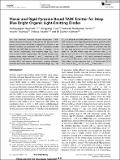Planar and rigid pyrazine based TADF emitter for deep blue bright organic light emitting diodes
Date
28/04/2021Author
Grant ID
EP/P010482/1
EP/R035164/1
749557
838885
Keywords
Metadata
Show full item recordAbstract
Two blue thermally activated delayed fluorescence (TADF) emitters bearing di‐tert‐butyl carbazoles as the electron donor groups and pyrazine (DTCz‐Pz) or dipyrazine (DTCz‐Pz) as the electron acceptor are presented. The DFT calculations predict DTCz‐Pz and DTCz‐DPz to possess high S1 energies (3.19 eV and 3.08 eV, respectively), and relatively large ΔEST values (0.52 eV and 0.56 eV, respectively). The closely layered intermediate triplet states between S1 and T1 , predicted by DFT calculations, are expected to facilitate the reverse intersystem crossing (RISC) and improve spin‐vibronic coupling efficiency between the excited states even the relatively larger ΔESTs. The ΔESTs for DTCz‐Pz and DTCz‐DPz are 0.27 eV and 0.38 eV, and both molecules show high photoluminescence quantum yields (65%, and 70%, respectively) and the decay lifetimes show temperature dependence in a PPT host, which is consistent that both molecules are TADF emitters in PPT. The OLEDs based on DTCz‐Pz exhibit deep blue emission with λEL of 460 nm and CIE of (0.15, 0.16). The maximum external quantum efficiency (EQEmax) reaches 11.6%, with a maximum luminance (Lmax) of up to 6892 cd m‐2 , while the device based on DTCz‐DPz exhibits sky blue emission with λEL of 484 nm and CIE of (0.15, 0.30), an EQEmax of 7.2%, and Lmax of 8802 cd m‐2 .
Citation
Rajamalli , P , Chen , D , Madayanad Suresh , S , Tsuchiya , Y , Adachi , C & Zysman-Colman , E 2021 , ' Planar and rigid pyrazine based TADF emitter for deep blue bright organic light emitting diodes ' , European Journal of Organic Chemistry , vol. 2021 , no. 16 , pp. 2285-2293 . https://doi.org/10.1002/ejoc.202100086
Publication
European Journal of Organic Chemistry
Status
Peer reviewed
ISSN
1434-193XType
Journal article
Description
Funding: Engineering and Physical Sciences Research Council (Grant Number(s): EP/P010482/1, EP/R035164/1); H2020 Marie Skłodowska-Curie Actions (Grant Number(s): 749557, 838885); China Scholarship Council (Grant Number(s): 201603780001).Collections
Items in the St Andrews Research Repository are protected by copyright, with all rights reserved, unless otherwise indicated.

